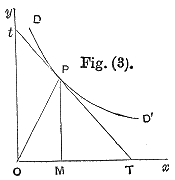|
Amoroso–Robinson Relation
The Amoroso–Robinson relation, named after economists Luigi Amoroso and Joan Robinson, describes the relation between price, marginal revenue, and elasticity of demand. \frac=p\left( 1+\frac\right), where *\scriptstyle \frac is the marginal revenue, *x is the particular good, *p is the good's price, *\epsilon_<0 is the price elasticity of demand
A good's price elasticity of demand (E_d, PED) is a measure of how sensitive the quantity demanded is to its price. When the price rises, quantity demanded falls for almost any good, but it falls more for some than for others. The price elastici ... .
Extension and generalization In 1967, Ernst Lykke Jensen published t ...[...More Info...] [...Related Items...] OR: [Wikipedia] [Google] [Baidu] |
Luigi Amoroso
Luigi Amoroso (26 March 1886 – 28 October 1965) was an Italian neoclassical economist influenced by Vilfredo Pareto. He provided support for and influenced the economic policy during the fascist regime. Work The microeconomical concept of the Amoroso–Robinson relation is named after him (and Joan Robinson): according to paper he is one of the first economists to have studied the dynamical equilibrium theory by using an analogy between economic systems and classical mechanics, thus applying to theories of economical behaviour mathematical tools as the calculus of variation. In his young years he contributed to the theory of functions of several complex variables, giving for the first time a set of necessary and sufficient conditions for the solvability of the Dirichlet problem for holomorphic functions of several variables in the paper . Also, in 1927 he provided to his former '' Normale'' schoolfellow Mauro Picone the funding for the creation of the '' Istituto Naziona ... [...More Info...] [...Related Items...] OR: [Wikipedia] [Google] [Baidu] |
Joan Robinson
Joan Violet Robinson (''née'' Maurice; 31 October 1903 – 5 August 1983) was a British economist well known for her wide-ranging contributions to economic theory. She was a central figure in what became known as post-Keynesian economics. Biography Before leaving to fight in the Second Boer War, Joan's father, Frederick Maurice, married Margaret Helen Marsh, the daughter of Frederick Howard Marsh, and the sister of Edward Marsh, at St George's, Hanover Square. Joan Maurice was born in 1903, a year after her father's return from Africa. During World War II, Robinson worked on a few different Committees for the wartime national government. During this time, she visited the Soviet Union as well as China, gaining an interest in underdeveloped and developing nations. Robinson was a frequent visitor to Centre for Development Studies (CDS), Thiruvananthapuram, India. She was a visiting fellow at the Centre in the mid-1970s. She instituted an endowment fund to support public ... [...More Info...] [...Related Items...] OR: [Wikipedia] [Google] [Baidu] |
Marginal Revenue
Marginal revenue (or marginal benefit) is a central concept in microeconomics that describes the additional total revenue generated by increasing product sales by 1 unit.Bradley R. chiller, "Essentials of Economics", New York: McGraw-Hill, Inc., 1991.Edwin Mansfield, "Micro-Economics Theory and Applications, 3rd Edition", New York and London:W.W. Norton and Company, 1979.Roger LeRoy Miller, "Intermediate Microeconomics Theory Issues Applications, Third Edition", New York: McGraw-Hill, Inc, 1982.Tirole, Jean, "The Theory of Industrial Organization", Cambridge, Massachusetts: The MIT Press, 1988.John Black, "Oxford Dictionary of Economics", New York: Oxford University Press, 2003. To derive the value of marginal revenue, it is required to examine the difference between the aggregate benefits a firm received from the quantity of a good and service produced last period and the current period with one extra unit increase in the rate of production. Marginal revenue is a fundamental to ... [...More Info...] [...Related Items...] OR: [Wikipedia] [Google] [Baidu] |
Elasticity Of Demand
A good's price elasticity of demand (E_d, PED) is a measure of how sensitive the quantity demanded is to its price. When the price rises, quantity demanded falls for almost any good, but it falls more for some than for others. The price elasticity gives the percentage change in quantity demanded when there is a one percent increase in price, holding everything else constant. If the elasticity is −2, that means a one percent price rise leads to a two percent decline in quantity demanded. Other elasticities measure how the quantity demanded changes with other variables (e.g. the income elasticity of demand for consumer income changes). Price elasticities are negative except in special cases. If a good is said to have an elasticity of 2, it almost always means that the good has an elasticity of −2 according to the formal definition. The phrase "more elastic" means that a good's elasticity has greater magnitude, ignoring the sign. Veblen and Giffen goods are two classes of go ... [...More Info...] [...Related Items...] OR: [Wikipedia] [Google] [Baidu] |
Good (economics)
In economics, goods are items that satisfy human wants and provide utility, for example, to a consumer making a purchase of a satisfying product. A common distinction is made between goods which are transferable, and services, which are not transferable. A good is an "economic good" if it is useful to people but scarce in relation to its demand so that human effort is required to obtain it.Samuelson, P. Anthony., Samuelson, W. (1980). Economics. 11th ed. / New York: McGraw-Hill. In contrast, free goods, such as air, are naturally in abundant supply and need no conscious effort to obtain them. Private goods are things owned by people, such as televisions, living room furniture, wallets, cellular telephones, almost anything owned or used on a daily basis that is not food-related. A consumer good or "final good" is any item that is ultimately consumed, rather than used in the production of another good. For example, a microwave oven or a bicycle that is sold to a consum ... [...More Info...] [...Related Items...] OR: [Wikipedia] [Google] [Baidu] |
Price
A price is the (usually not negative) quantity of payment or compensation given by one party to another in return for goods or services. In some situations, the price of production has a different name. If the product is a "good" in the commercial exchange, the payment for this product will likely be called its "price". However, if the product is "service", there will be other possible names for this product's name. For example, the graph on the bottom will show some situations A good's price is influenced by production costs, supply of the desired item, and demand for the product. A price may be determined by a monopolist or may be imposed on the firm by market conditions. Price can be quoted to currency, quantities of goods or vouchers. * In modern economies, prices are generally expressed in units of some form of currency. (More specifically, for raw materials they are expressed as currency per unit weight, e.g. euros per kilogram or Rands per KG.) * Although ... [...More Info...] [...Related Items...] OR: [Wikipedia] [Google] [Baidu] |
Price Elasticity Of Demand
A good's price elasticity of demand (E_d, PED) is a measure of how sensitive the quantity demanded is to its price. When the price rises, quantity demanded falls for almost any good, but it falls more for some than for others. The price elasticity gives the percentage change in quantity demanded when there is a one percent increase in price, holding everything else constant. If the elasticity is −2, that means a one percent price rise leads to a two percent decline in quantity demanded. Other elasticities measure how the quantity demanded changes with other variables (e.g. the income elasticity of demand for consumer income changes). Price elasticities are negative except in special cases. If a good is said to have an elasticity of 2, it almost always means that the good has an elasticity of −2 according to the formal definition. The phrase "more elastic" means that a good's elasticity has greater magnitude, ignoring the sign. Veblen and Giffen goods are two classes of go ... [...More Info...] [...Related Items...] OR: [Wikipedia] [Google] [Baidu] |
Ernst Lykke Jensen
Ernst is both a surname and a given name, the German, Dutch, and Scandinavian form of Ernest. Notable people with the name include: Surname * Adolf Ernst (1832–1899) German botanist known by the author abbreviation "Ernst" * Anton Ernst (1975-) South African Film Producer * Alice Henson Ernst (1880-1980), American writer and historian * Britta Ernst (born 1961), German politician * Cornelia Ernst, German politician * Edzard Ernst, German-British Professor of Complementary Medicine * Emil Ernst, astronomer * Ernie Ernst (1924/25–2013), former District Judge in Walker County, Texas * Eugen Ernst (1864–1954), German politician * Fabian Ernst, German soccer player * Gustav Ernst, Austrian writer * Heinrich Wilhelm Ernst, Moravian violinist and composer * Jim Ernst, Canadian politician * Jimmy Ernst, American painter, son of Max Ernst * Joni Ernst, U.S. Senator from Iowa * K.S. Ernst, American visual poet * Karl Friedrich Paul Ernst, German writer (1866–1933) * Ken E ... [...More Info...] [...Related Items...] OR: [Wikipedia] [Google] [Baidu] |
Lerner Index
The Lerner index, formalized in 1934 by British economist of Russian origin Abba Lerner, is a measure of a firm's market power. Definition The Lerner index is defined by: L=\frac where P is the market price set by the firm and MC is the firm's marginal cost. The index ranges from 0 to 1. A perfectly competitive firm charges P = MC, L = 0; such a firm has no market power. An oligopolist or monopolist charges P > MC, so its index is L > 0, but the extent of its markup depends on the elasticity (the price-sensitivity) of demand and strategic interaction with competing firms. The index rises to 1 if the firm has MC = 0. The following factors affect the value of the Lerner index: * the price elasticity of demand for goods produced by the company — the smaller the fluctuations in demand under the influence of prices, the smaller the elasticity and the greater the value of L; * the interaction with competitors — the more of them and the larger their size, the less the company's ... [...More Info...] [...Related Items...] OR: [Wikipedia] [Google] [Baidu] |
Ramsey Problem
The Ramsey problem, or Ramsey pricing, or Ramsey–Boiteux pricing, is a second-best policy problem concerning what prices a public monopoly should charge for the various products it sells in order to maximize social welfare (the sum of producer and consumer surplus) while earning enough revenue to cover its fixed costs. Under Ramsey pricing, the price markup over marginal cost is inverse to the price elasticity of demand: the more elastic the product's demand, the smaller the markup. Frank P. Ramsey found this 1927 in the context of Optimal taxation: the more elastic the demand, the smaller the optimal tax. The rule was later applied by Marcel Boiteux (1956) to natural monopolies (industries with decreasing average cost). A natural monopoly earns negative profits if it sets price equals to marginal cost, so it must set prices for some or all of the products it sells to above marginal cost if it is to be viable without government subsidies. Ramsey pricing says to mark up most th ... [...More Info...] [...Related Items...] OR: [Wikipedia] [Google] [Baidu] |



